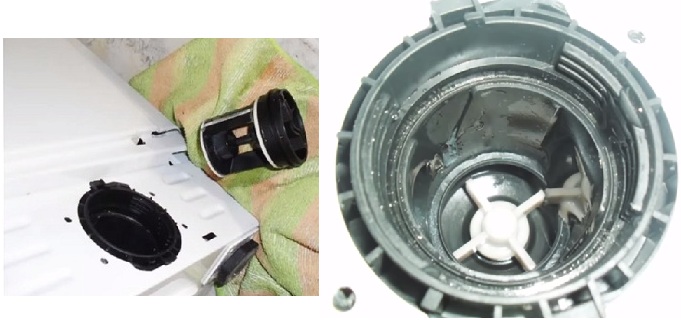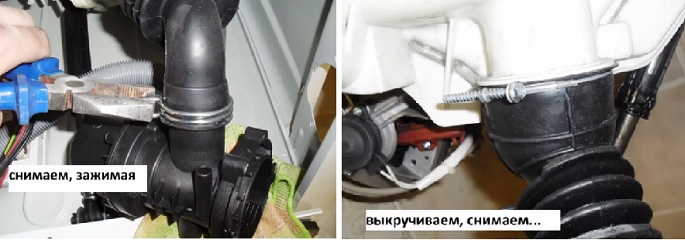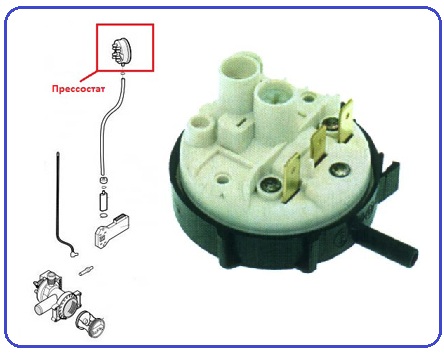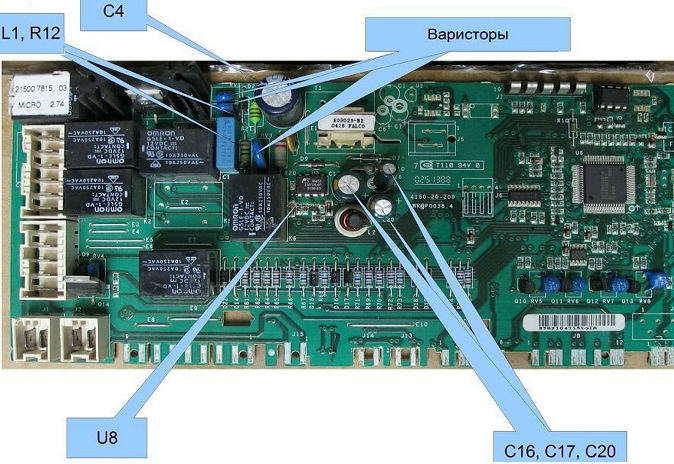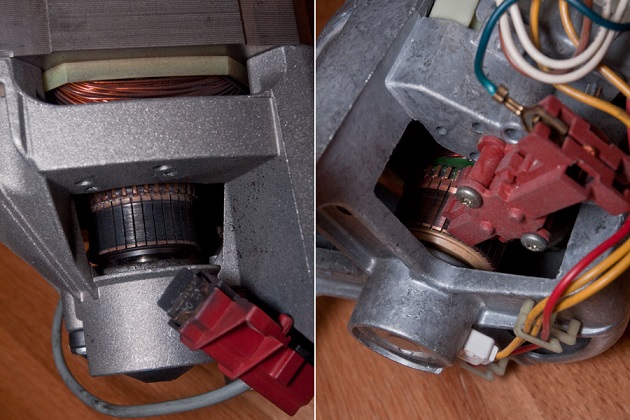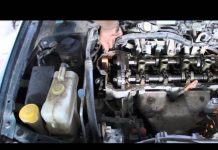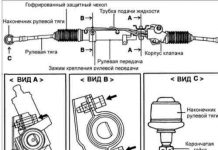In detail: indesit wisl 92 DIY repair from a real master for the site my.housecope.com.
Every breakdown is accompanied by the presence of symptoms.
Some have a clear sign (visual) - mechanical, burning smell, destruction of components and devices.
And some hidden defect. These are the most insidious, since you have to check the entire chain of devices and the time is delayed. Especially with an inexperienced master.
Almost all Indesit models wisl 103, wisl 105, wisl 83, wisl 82, wisl 102 are based on the EVO II control module with a collector motor.
Therefore, their design and repair will be very similar.
- Explanation of the error code by flashing indicators:
By adding the numbers corresponding to the blinking LEDs, you will receive an error code.
As an example of error F10, add the sum 8 + 2 = 10 (F10).
- Malfunctions by error code:
F01 - the signal is lost between the control board and the motor.
We measure the control voltages on the motor control block with a tester:
The motor control thyristor may have become unusable. Also ring the motor terminals.
F02 - no signal from the engine tachogenerator and the electronic module.
We also check the engine block and connector.
We make sure that the tachogenerator is working properly:
The tacho sensor monitors the rotation speed of the motor rotor.
When it turns, an alternating voltage is generated at the terminals of the tachogenerator coil.
The frequency is compared by an electronic board and the rotation of the drum is monitored.
It is enough to tighten the sensor mounting screws or glue it in order to restore the correct operation of the engine.
The resistance of the contact group in a quiescent state should be about 70 ohms. Without removing the test leads from the coil lead terminals, rotate the motor shaft. Resistance, in this case, should change. If this happens, then the tachogenerator is working properly.
| Video (click to play). |
F03 - breakage of the temperature sensor (thermistor), breakdown of the processor on the module.
The sensor itself rarely fails. Usually there is no signal from the board (connector pins)
First, ring the temperature sensor, reflash the ROM, ring the kilo-ohm resistors. If it does not help, a replacement board.
F05 - the drain pump or pressure switch (level sensor) does not work.
By 80 percent, a blockage (filter, drain hose) or a pump is to blame.
We clean the filter by removing the front panel with a flat screwdriver and screw it around:
The pump impeller must be clean and free of debris:
We put the washing machine on its side and separate the pipe from the tank and pump:
If error F05 pops up again - the reason is in the electrics, namely why the pumping pump does not work?
We take the multimeter in our hands and, starting the drain program, measure the voltage at the pump terminals. It should be 220 volts.
His presence tells us about the replacement of the pump.
F07, F08 - the heating element is not in the water, does not work (burnt out or open).
Make sure there is water in the tank by looking into the drum. Further, after removing the back wall, check the heating element with a tester:
F04, F08 - pressure switch (water level switch).
The presence of a signal from the connector.
Check the condition of the level sensor:
- contacts-2-4 are closed - level "EMPTY TANK"
- contacts 2-3 are closed - level "FULL TANK"
- contacts 2-1 closed - “OVERFLOW” level (not less than half the glass level of the loading door.
Remove the top cover by unscrewing the two screws at the back. This sensor is on the top:
Why is it needed?
For adjusting the water level in the tank: low, medium and high. Also provided with protection against tank overflow.
How to check?
Just blow into it. You should hear clicks. There may be three. Depends on the water levels provided by the program: economical, delicate, half load.
F09 the memory card of the electronic board is faulty.
F10 - the water intake time has been exceeded.
The filler pipe from the detergent drawer to the tank may be clogged, the water inlet valve is not working properly.
Also check the level sensor (see above).
F11 there is a problem with the drain pump.
The resistance of the pump winding should be about 170 ohms - measure it with a tester.
Follow the instructions for error F05
F12 - there is no signal between the control board and the program selector.
Carry out an external examination of the board for damage to the elements.
If no burned-out nodes were detected, 1 processor diagnostics is required:
just check the reset pins (133DDB), crystal, 50Hz signal, DATA and CLK.
2. Failure of the microcontroller: Usually the reason is that due to actuators or for other reasons, the triacs for controlling the lock (Q9) and valves (Q10-Q13) explode. In this case, SMD resistors always burn out between the terminals of U6 and the control electrodes of the triac (560 Ohm), sometimes also between them and the common wire (1 kOhm).
The designations on the resistors are 561 and 102, respectively. 561 triacs must be replaced, even if it looks intact!
In these cases, the corresponding pins of the U6 microcircuit are always damaged.
It is best to remove a non-working microcircuit with a soldering station (hot air gun).
In its absence, you can use a very sharp knife and carefully cut off all the leads, being careful not to damage the printed conductors, and then simply remove their remnants from the board with a soldering iron and braid with flux. Another way: while heating the leads with a soldering iron, slip a safety razor blade under them, or, passing a loop of thin nichrome wire under them from the inside, carefully pull it out, also heating the leads in turn with a soldering iron.
After replacing U6, you can partially check the operation of the module: immediately after connecting to the network, a constant voltage of 5 volts should appear between the contacts for pins 4 and 8 of the memory chip U3, and after about 20 seconds relay K6 will click. This will happen even if no external devices are connected and there is no memory chip.
After the failure of one of the triacs, before installing the recovered board into the machine, you should check the device (lock or valve) connected to the corresponding output of the board in order to avoid repeated damage. For example, include a 75.100 W incandescent lamp in the open circuit of the triac device and install a program to start this device. Or just plug it in in series with the lamp. It should not glow brightly.
Triacs are rated for a maximum current of 0.8. 1 A, in reality, the lock thermostat and valves consume no more than 0.2 A through the triac circuit. In all cases, after repair, you should make sure that the data is safe in the U3 memory chip (24C64). If necessary, replace (reprogram) it according to the model.
F17 - hatch lock lock problem.
No power supply to the door lock - ring the contacts.
- When turned on, all the lights on the panel start blinking, like a garland.
Pay attention to the power supply of the control board - these are swollen capacitors C17, C16, C20.
We select new capacitors, it is possible for 1000 uF. We take a soldering iron and change it.
- A frequent defect - the machine does not work, the blocking lock works, the washing program starts and then there is silence.
Check the hatch lock, its contacts and wiring. Next, we look at the brushes of the electric motor.
If the working overhang of the coals is less than 7 mm, they must be replaced (both must be changed). To do this, disconnect the wire and pulling out the contact, remove it.
We remember in which direction the graphite contacts are ground. We clean the collector lamellas with a zero skin. Remove dust with a vacuum cleaner. Install new ones, making sure that they fit snugly to the collector.
If necessary, grind off the graphite with sandpaper. Fix the motor to the tank, connect the power wires, but do not put on the drive belt. Start spinning and rub in to reduce friction, then collect the remaining parts.
The popularity of the tyralny machines Indesit received due to the low cost. But for the initial cheapness you have to pay extra with repairs - the reliability of the brand is in question.
But you can repair the Indesit washing machine with your own hands and eliminate many breakdowns if you have basic knowledge of mechanics, electrical and electronics.
First of all, you need to determine what kind of breakdown occurred. Initial diagnostics will help you decide if it is possible to fix the problem yourself or if you still have to spend money on professional repairs.
The right step would be to have a preliminary acquaintance with the scheme of the washing machine in order to have an idea of where everything is.
Sometimes, to determine the cause of the failure of household appliances, it is enough to read the instructions for use, which, among other things, contains recommendations for eliminating breakdowns.
The first step is to take a look at the display. If it is impossible to complete the specified process, the washing machine issues special codes on the display.
Error codes in the operation of the washer are given in the instructions that the manufacturer must attach to his own product:
With the help of a very useful multimeter device, it is possible to check various contacts, wiring, sensors. The device will show if there is power everywhere.
Sometimes it is enough to listen to the sound emitted by the unit. When the washing machine starts to creak, make excessive noise, and sometimes rattle, then, most likely, there are problems in the bearings or the drum, the oil seal is damaged, the counterweight fasteners are loose, the shock absorbers are in poor condition.
Calling the wizard is the only correct solution when:
- the warranty period has not expired - if the operating rules are followed, the repair will be free;
- threatening smoke came from the car.
In other cases, there are said to be options. But always the first stage of repair begins with disconnecting the faulty equipment from the mains. For negligence, electricity will punish necessarily and severely. An indispensable rule of a home master: do not act at random, use the instructions.
When the display does not report a malfunction, there are no leaks, smoke, burning smell, then usually the problem is easy to fix:
- If home laundry won't turn on, first you need to check if the plug is firmly inserted into the outlet. Occasionally, the washing machine can shut down due to power surges. It is also necessary to make sure that the operating mode is set correctly on the control panel;
- When water does not flow into the tank, it is recommended to press the button responsible for starting and stopping the unit again, make sure that the door is closed tightly. Sometimes the fault is insufficient pressure in the water supply system, perhaps the tap was simply turned off, the hose was damaged. The reason may lie in the failure of both the program and the control system. Elimination occurs by repeated access to the "Start / Pause" button;
- When the drain is not working first you need to check the filter - sometimes it is enough just to clean it.
And the source of the frightening rumble can be any object (for example, a coin) that accidentally ends up in the drum.
This is a fairly frequent breakdown, although the declared service life of the heating element is 10-15 years. However, numerous washes in very hot and hard water, constant overloading of the tank, and low-grade detergents do an evil deed.
Over time, a kind of "coat" of various salts is formed on the heating element. It breaks down from overheating, it is no longer possible to restore it. A heater malfunction is indicated by a cold hatch when the wash mode is on and, of course, laundry that has not been washed in cold water.
Replacing a damaged part is quite simple: the manufacturers have placed the heating element in such a way that it is easy to get to it by opening the back cover of the case. The only inconvenience is that the car needs to be disconnected from all communications in order to turn the right side for repair. The heating element is placed under the drum pulley. Care should be taken when disconnecting and replacing the wiring board.
A minimum of tools will be required: a flat and curly screwdriver, a key with a head are enough. You will also need a multimeter or tester to check the heating element. It is wiser to buy a new heater, the original Italian one.
- Disconnect the unit from all communications.
- Unscrew the bolts around the perimeter of the cover.
- Further, under the tank, you need to find the contacts of the heating element and attach the multimeter probes to them. Normal resistance is 25-35 Ohm, other indicators indicate a malfunction.
- The next operation: disconnecting all wires with terminals, fixing their position in memory.
- Then the nut is unscrewed on the bolt, the end of which is located in the center of the heater base.
- In order for the bolt to go into the hole, it should be gently knocked over it.
- Pull out the heating element base by picking it up with a flat screwdriver.
- Move the thermal sensor from the damaged part to the new heating element.
- Clean out the formed debris from the seat for the electric heater.
- Leave the new heating element in its intended place, fasten it with a bolt.
Then it remains to return the wires to their original position, close the rear cover of the machine and restore the connection with communications.
This is also a fairly common problem. The pump is a weak point of automatic washing machines. In addition to a blockage, when it is enough to clean the hose and filter, the impeller can jam. It is located behind the drain filter, which must be unscrewed and removed.
To prevent the impeller, you need to try to rotate. It should not be too light: in a normal state, the impeller rotates with certain delays due to the magnet in the coil. Sometimes threads, hair, laces and other similar debris wrap around the impeller so that they even block it. All these interferences must be removed.
It happens that the plastic body is deformed and begins to clamp the blades. When there is no possibility of replacement, the blades must be cut with a knife by no more than 2 mm, and the washing machine can still be used.
If after that the work is not restored, then the breakdown is more significant and requires a detailed inspection - the pump will have to be disassembled. The car is laid on its side, the screws that fix the pump to the casing are unscrewed, the electric cable and 2 hoses are disconnected.
Clean the hoses if necessary. The tester checks the motor windings to eliminate the possibility of breakage. Typical resistance values here are 150-300 ohms.
Without hoping for memory, it is worth noting the orientation of the pump relative to the engine I. Then the pump motor is disconnected from the housing, the rotor is removed from the stator. Often everything inside is clogged with dirt that interferes with the rotation of the rotor. In such cases, a thorough rinsing is required.
The rotor axis bearing is lubricated with lithium, the oil seal is adjusted. Subsequent assembly is carried out using a sealant to prevent leaks.
If you follow the instructions for caring for your washing machine and clean the drain hose every 6 months, the likelihood of breakage of the drain system will be greatly reduced.
Indesit's motor is well-designed, reliable and durable. However, nothing is eternal, and at one not very beautiful moment, the "heart of the machine" may fail. The reason can be not only wear of the mechanism, but also excessive overload.
- First, the outer panels are removed from the machine, usually the top and rear.
- O Disconnect the supply wires.
- Remove the belt from the pulley.
- Screw the fasteners, remove the motor.
After diagnostics, the final decision is made to repair or replace the engine. Usually they tend to the latter option - it is difficult to restore the engine, it is easier to completely replace it. The installation of a new engine is carried out in the reverse order.
Before disassembly, the assembly should be photographed, then there will be no problems with what to screw in.
When in a working washing machine, especially during spinning, unusual sounds appear, and not episodic, but gradually increasing, this is a clear signal of a malfunction of the bearings, which indicates the ease of rotation of the drum.
Do-it-yourself repair in such a situation is possible, but you cannot call it simple - you need extreme care, strict adherence to the sequence of operations:
- Remove the top and rear panels.
- Remove dispenser, control unit.
- Twist the cuff clamp, remove the cuff itself and the hatch locking device.
- Remove the front wall and counterweight.
- Remove the tubular electric heater, noting the sequence of connecting the wires in memory.
- Disconnect the parts connected to the drum tank, dismantle the drive belt and motor.
- Remove the tank, place it on a flat place with the pulley up, then unscrew the pulley bolt, remove the pulley itself.
- Using a mallet (you can use a simple hammer and a wooden gasket) to sink the shaft down, untwist and divide the tank into two halves.
- Remove the bearing with a special puller, dismantle the old oil seals.
- After installing fresh oil seals, press in a new bearing.
The assembly of the washing machine is carried out in reverse order with strict sequence of operations. To prevent the tank from leaking, all seams must be sealed.
The main thing when replacing a bearing is care and adherence to the sequence of operations.
A flabby hatch lock can cause another nuisance - the washing machine will stop turning on. The shut-off device is also equipped with contacts, and when something prevents complete closure, electricity does not flow to the units of the unit.
Failure is usually caused by the accumulated dirt in the lock. After its elimination, the normal operation of the device, as a rule, is restored.
And the mortiser s dampens excessive vibrations that appear in the washing machine. This is especially necessary during spinning, when the rotating drum is at the highest speed. Over time, they diminish in effectiveness.
As a result - excessive vibration, atypical noises, knocking during the spin cycle. A common cause of failure is the wear of the gaskets and separating the piston and cylinder, which subsequently deform.
The shock absorber cylinder contains a rod, consisting of a rod and a gasket treated with a high-friction lubricant. Oscillations are damped by moving the piston.
The jerky jerk of the tank forces the piston into the cylinder, reducing vibration. There is also a spring in the cylinder that returns the piston to its original position - it is called the return one.
To get to the shock absorbers, you will have to remove the rear panel (in some modifications, the side or front cover can be removed). After unscrewing the nut at the bottom of the shock absorber, it is disconnected from the body. In the same way, the part is released from above. A new shock absorber is installed in place of the old one and fixed in the reverse order.
In the latest models, instead of shock absorbers, dampers are used, where the return spring has been replaced by a whole spring system attached to the upper area of the tank and providing it with a "suspended" position. This design is more reliable, better dampens unwanted shocks.
To check the performance, the damper must be removed from the case by unscrewing the bolt in its lower segment, and try to press on it so as to compress and then unclench the mechanism. If the result is minimal, the device is in normal working condition. When the piston easily changes position, the damper needs to be replaced.
It is removed from the case in the same way as conventional shock absorbers, although in some models the mounting bolts are replaced with plastic pins with latches. Install the new damper in the usual way - in reverse order with respect to the assembly.
It happens that the detergent does not want to leave the tray. This usually happens when he is poured there without measure. The problem disappears with the correct dosage.
Weak water pressure can also be to blame. It is worth trying to clean the filter where the washing machine connects to the inlet hose.
Another option is to increase the pressure at the tap supplying water. Sometimes water cannot enter the tray due to a blocked valve. Then you should pull out the tray, find the valve in the form of a key and carefully clean it.
These are the most common causes of improper detergent powder behavior and can be easily dealt with without the help of a professional. A more difficult case would be a problem with the water inlet valve where the powder does not leave the tray at all. Valve replacement is already required. The same can be said about the solenoid valve, which is responsible for filling the cuvette with water with water.
The control unit in Indesit washing machines does not have reliable protection against moisture, as a result, condensate gets on the contacts, short circuits occur, which take the device out of the working state.
Repair requires subtle diagnostics in the "Autotest" mode, serious knowledge in radio engineering, masterly possession of a soldering iron, skills in handling microcircuits, boards, semiconductors. This is usually the area of expertise of skilled professionals.
For the rare daredevils from the army of home crafts, the most general tips:
- remove the cover from the control unit;
- remove the module;
- inspect faulty contacts and connections;
- evaporate damaged parts;
- solder conditioning elements in their place.
But work with electronics is far from being for everyone, so we recommend that you abandon experiments and turn to professionals.
You can get acquainted with the practical application of tips for repair and replacement of spare parts by watching informative videos.
Quick replacement of heating elements in the Indesit washing machine:
How to change the bearing yourself:


